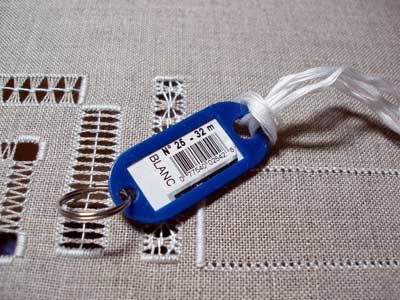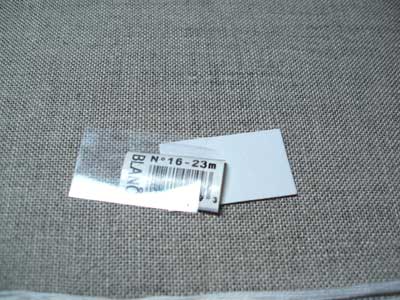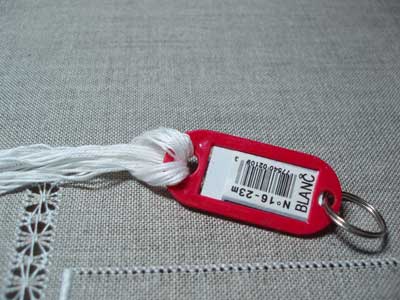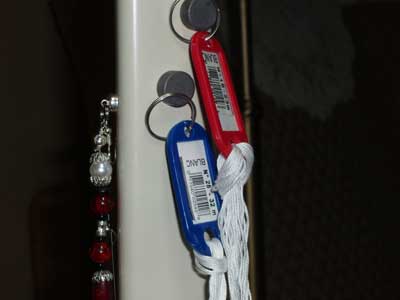I mentioned the other day when discussing needlework thread organization that a trip to the office supply store inspired an idea for organizing threads. Here’s the story.
It all started with shoppig that had nothing to do with needlework or embroidery of any kind! I went to Office Depot a while back to pick up one thing (transparencies for my classroom), and walked out with a selection of completely unrelated items. (Can you relate?!) While I was meandering down the paperclip aisle, my attention was arrested by a package of colored key chain tabs. I had some of these at work. It struck me funny that they were available at an office supply store. I always thought they came from hardware stores.
While this thought was flitting through my mind, I noticed two convenient things about the tabs that I had never noticed before. The first was that they have a relatively large hole on the end opposite the ring. The second was that they have a clear plastic cover over the small rectangular name plate thing.
Thoughts of embroidery, needlework, fabric, thread – anything and everything related to this addiction of mine – are never far from my mind. Holding the package of little key chain tabs (8 for $2), I found my mind constructing them into thread organizers, not key chains. And so I added it to my cart…

This may not at all be even remotely original. I would imagine that, out there somewhere, other people have used these types of things for thread organizers.

What I like particularly about using them is that you can slide the label off the thread, cut it in half so that you have the size indication there (or color indication, depending on the thread), place the clear plastic cover over the label, and slip both into the keychain, where they remain, undamagable for the most part, until you are finished with the thread.
On the plaited-around-the-label threads that I showed you the other day, over time it is not unusual for the label to tear a bit, especially if the threads are pulling on it as you pull them out. With this whole keychain doohickey, the label is forever intact.

The hole on the end opposite the key ring is a perfect place to loop your threads. If you want to braid them, you can. Or, you can simply fold the length of thread in half, feed it through the hole at the fold until you have a few inches through the hole, then stick your finger into the loop and grab the rest of the thread hanging out of the other side of the hole, pull it through the loop, and tighten it a bit to secure it. Now, when you want a thread, you just take one individual thread and pull it off. Braiding will keep the whole skein in a little better order, but it also takes more time. On the bright side, with that key ring on the other end, it’s easy as pie to braid, because you can secure that ring over something and braid very quickly.

Now, the metal key ring comes in handy on two accounts. If you like to keep your threads on a larger ring, you can easily thread all those rings onto a larger ring and slip the whole lot of them into a larger bag for transport.
As for me… well, I’m a magnet freak. Not a decorative magnet freak. A utilitarian magnet freak. I like magnets – they come in handy for needlework, and I have a superfluous amount of the stronger ceramic types (not craft magnets, but rather the kind you buy at electronic stores, etc.) dotting the pole on my light. The key rings stick right to the magnets, making it very convenient to line up a few types of thread within easy reach on my light pole.
What I’d really like to do, though, is make a little dowel rack of some sort – one that could sit on a table or clamp to a stand or frame, or stick on a light pole (with strong magnets). The dowels, according to the plan in my head, would be thin enough to accommodate the center holes in the Access Commodities threads, and they would serve as a perfect place to slide a bunch of key chain rings, too. Well, if that ever materializes, I will surely let you know!
So that’s my latest way of keeping my whitework threads at my fingertips while I’m stitching. At the end of a session, I simply gather them up and slip them into my basket, so that they aren’t collecting dust while hanging on the lamp post.
If you were going to go with the key tabs for organizing a large number of threads, I think I’d look for a place where they could be purchased in bulk for a lot less. The 8 / $2 thing was a special – I think they run normally about $3 for a package of 8, which is kind of ridiculous if you’re planning on organizing a lot of thread. But for a project with a limited range of threads, it’s a neat way to keep them all marked and together.
So here endeth the lesson… and I’m off to spend some quality time with my needle ‘n thread! Updates on the whitework sampler, coming up…







What a good idea. I love the hemstitching and weaving you have used as a background – is this the next one on whitework sampler? Hope so.
Great inspiration! I love magnets also; have you seen the rare-earth magnets? They are so strong! I love your decorative ones too.
-Christiana
The key tags are a great idea for organizing threads for a specific project. The magnets are cool too. Have you heard of magnetic paint? I’m thinking of getting some and making a magnet board for holding stuff in my studio.
What a great idea…It’s one of those “Now why didn’t I come up with that?” things 🙂
I love silks and find that the best way for me to store them and not get them tangled, is to hang them. This makes a great alternative to keeping them on their original hang tags – which tear and also snag.
Thanks so much!
Off to the office supply store 🙂
Hugs, Marlon
Thank you very much for sharing this great idea!
I always admire your work!
This is brilliant! I usually do the ol’ hole punch a piece of card and thread them through the holes, but this is a great idea. And instead of keyrings, if they were replaced with small carabina’s you could have all your threads suspended on a rail and select off the ones you want by unclipping them. Huge potentials…!!
Hello,
I found your site today and was so thrilled about the free tutorial videos. I’ve been bad at embroidery for years because of not watching anyone do it.
One of my upcoming projects is some pillowcases, which I’m thinking about doing whitework (well, natural-work) on. I have two questions. First, is it necessary to embroider on one layer, or could it work to make a normal hem on the case first and then embroider it? Or if I make a hem, is it better to embroider it first and then fold it over and sew it?
Second question- I bought some Mettler silk-finish mercerized cotton thread a little while ago, which was advertized as good for handsewing. Is it also good for embroidery, or is it not as thick as something like the coton a broder?
Any suggestions would be greatly appreciated… Thanks for the great site and the free patterns!
-Goldberry
Hi, Goldberry –
Well, I think I would embroider first on the pillow case, then turn it and hem it. That way, the back of the embroidery is covered – which is good for a couple reasons: 1. it’s protected, and 2. no one can see it!!
I haven’t tried the Mettler threads. They sound interesting – I wonder if anyone else out there has used them? I’ll ask… My guess, off the bat, is that it probably isn’t as thick as coton a broder. Hand “sewing” thread is usually fairly fine thread.
Best of luck on your pillow cases! And welcome aboard – I’m glad you’ve found my website!
Mary
I have the 1979 Reader’s Digest “Complete Guide to Needlework” which I love, but I need to start getting more books.
Hello,
I´d love to have the Metal Thread Embroidery book by Jane lemon.
Thanks,
Paul Phillip Evans
bordadodlujo@yahoo.com
It is a great idea! Thanks for sharing it.
I use dowel rods to organize rolls of ribbon. I clamp a bulldog paper clamp on one end of the rod. Then load the spools of ribbon. When full I add another clamp to the other end of the rod. I can hang the rod by opening the “wings”. It’s also portable. I prefer shorter rods, and organize according to color and ribbon size. You could do something similar with lighter plastic rods.
What count fabric would u surjest 4 casalguidi I can not find a book or pattern that surjest this on can only find patterns 4 the 4 sided stitch many thanks Christine look forward your reply